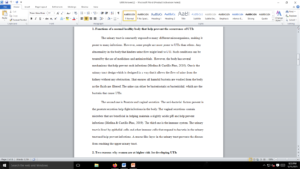Medicines and antimicrobials
Use the information presented in the module folder along with your readings from the textbook to answer the following questions.
1. Describe three (3) functions of a normal healthy body that help prevent the occurrence of UTIs
:2. List two reasons why women are at higher risks for developing UTIs
3. Briefly describe the two-step process used to diagnose UTIs. Which organism is most often responsible for causing UTIs?
4. What is Vaginosis? List some of the members of the normal microflora of the female reproductive organs and discuss factors that may contribute to an abnormal increase in these organisms.
5. Describe and explain the primary, secondary, latent, and tertiary stages of syphilis:
6. Explain why a person with AIDS is more susceptible to opportunistic infections. What diseases or conditions might a person with HIV or AIDS be more susceptible to?
plagiarism check,and apa formatting are very important
Requirements: 3pages
Answer preview
Different processes are used to diagnose UTIs. One of them is urinalysis. This process encompasses testing urine for red blood cells, white blood cells, and bacteria. The number of white and red blood cells in the urine is used to detect UTIs. The second process is urine culture, which determines the type of bacteria present in the urine (Medina & Castillo-Pino, 2019). This test is the most appropriate because it helps the health care practitioner determine the type of medication to administer. The most responsible organism that causes UTI is a microorganism called Escherichia coli (E. coli). This bacterium enters the urethra, causing inflammation and infection.
[1154 Words]

Medicines and antimicrobials

